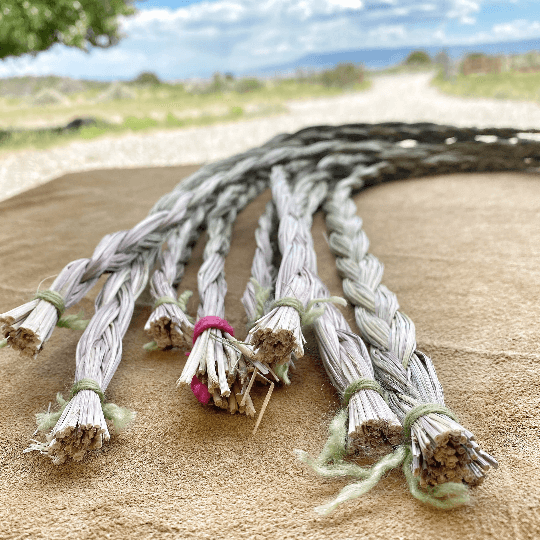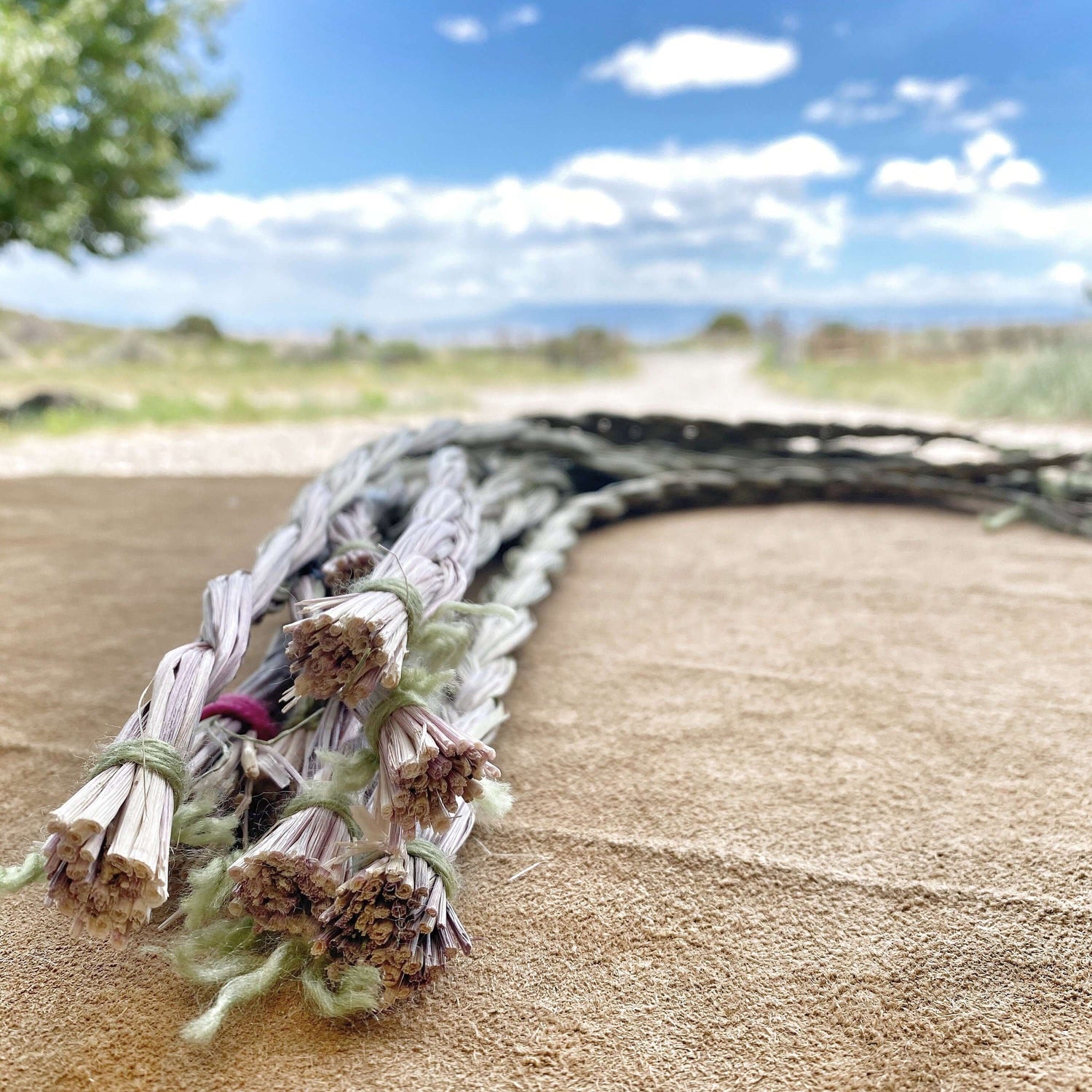The Ultimate Guide to Using Sweetgrass: Purify and Uplift Your Space
Cultural context • Aroma science • Ethical sourcing • Quick-start ritual • Room-by-room flow • Intention scripts • Ventilation & safety • Non-burn options • 7-day refresh • Troubleshooting • FAQs
Quick takeaway: Sweetgrass carries a beloved, vanilla-like aroma and deep cultural meaning in many Indigenous communities. If you choose to use it at home, lead with respect, emphasize ventilation & fire safety, and try non-burn methods where smoke isn’t appropriate. This guide gives you everything you need—from quick-start to weekly routines.
Quick-Start: Purify & Uplift in 5 Steps
- Open airways: crack a window/door; place a fireproof dish nearby.
- Set intent (1–2 lines): name what you’re releasing and what you’re inviting in.
- Light lightly: create a slow smolder—no steady flame.
- Flow the room: door → corners → windows → mirrors → center; then out the exit.
- Close & ground: fully extinguish in sand; say a short closing line and take 3 calm breaths.
What Sweetgrass Is (Botany & Aroma)

Sweetgrass (Hierochloë odorata) is a cool-climate perennial. Its signature fragrance comes from coumarin-related compounds that intensify as the plant dries—why a freshly braided strand often smells sweeter a day or two later. Braiding isn’t just beautiful: it helps the material dry evenly and burn slowly.
Scent notes: soft vanilla, hay-like sweetness, and a green, meadowy top note. Compared with sage or cedar, sweetgrass tends to feel lighter and gentler in a room.
Cultural Context & Respectful Language
Many Indigenous Nations steward ceremonial teachings connecting sweetgrass to prayer, purification, and community. Those ceremonies and the term “smudging” belong to the cultures who carry them. If you are not part of those communities, consider the more general term “smoke cleansing” and approach with humility—learning from local voices, supporting Native makers when you can, and avoiding claims that aren’t yours to make.
Practices, sequences, and meanings differ by Nation. There is no single “right way” outside of community guidance.
Sourcing Ethically: Harvest, Habitat & Authenticity
What ethical harvest looks like
- Clumps are cut, not uprooted, leaving crowns to regrow.
- Harvesters rotate patches and avoid sensitive habitats.
- Material is shade-dried with good airflow to prevent mold.
- Suppliers can share region, season, and batch details.
Quality & authenticity checks
- Even green-gold color; no gray or musty spots.
- Tight, uniform plait; no synthetic dyes or artificial fragrance.
- Clean, sweet aroma that opens when gently squeezed.
- Clear product page: species (Hierochloë odorata), braid length, and traceable batch info.
Why it matters: Ethical sourcing protects wild stands and the communities connected to them—and it tends to smell and burn better, too.
Room-by-Room Ritual Flow
- Entryway: sweep smoke across the threshold; “Only what serves may enter.”
- Living area: circle soft furnishings; pass behind sofas and under tables.
- Kitchen: trace counters, sink, stove; move clockwise to encourage a sense of order.
- Bedrooms: around bed corners, pillows, and closet interiors.
- Workspace: desk edges, chair back, electronics (briefly—avoid alarms).
- Finish at exit: waft smoke outward and close the ritual consciously.
Simple Intention Scripts
“I release what’s heavy and invite clarity, care, and calm.”
“May this space reflect kindness, focus, and safety.”
“What does not belong may go; what supports us may stay.”
Ventilation & Fire-Safety Cheat Sheet
- Cross-breeze: open two opposite windows/doors; place a fan blowing out near one opening.
- Less is more: a tiny ember = enough aroma; heavy smoke is unnecessary.
- Sensitive folks: keep sessions ≤ 5–10 minutes; consider a HEPA purifier on “high.”
- Hard no’s: never leave embers unattended; keep away from fabrics; extinguish cold to the touch in sand.
Safety-First Smoke-Cleansing (Step-by-Step)
- Prepare & ventilate: Tidy the area, open a window, and set a fireproof dish or sand nearby.
- Light lightly: Ignite the braid tip, then blow out for a gentle smolder—not an open flame.
- Mindful intention: Keep the focus calm and respectful; protocols vary by Nation.
- Waft safely: Use a hand or feather; keep embers over a dish; avoid smoke alarms and fabrics.
- Extinguish fully: Press the embered end into sand/dish until cold to the touch. Never leave embers unattended.
Sensitivity note: Smoke can irritate airways. Consider non-burn methods for homes with kids, elders, pets, or asthma.
Non-Burn Alternatives
- Short stovetop simmer: Simmer a small piece of braid in water for 2–3 minutes; turn off heat and let the aroma rise. Ventilate as needed.
- Steam bowl by a window: Pour hot water over a small braid piece; set near an open window for gentle fragrance.
- Breathable sachet: Tuck a small piece in a muslin bag for drawers/closets (see HowTo JSON on this page).
Apartment-friendly: These options respect building rules and reduce indoor smoke exposure while honoring the plant’s scent.
Care, Storage & Braid Upkeep
- Keep it dry & shaded: Store away from direct sun and humidity to preserve color and aroma.
- Revive the scent: A gentle squeeze releases aromatic oils. (If you burn, trim off the charred tip next time for a cleaner light.)
- Rebraid if needed: Lightly mist with water, wait a few minutes so strands are pliable, then rebraid gently and let fully dry before storing.
Sweetgrass vs. Sage vs. Cedar (Aroma Snapshot)
| Plant | Aroma feel | Smoke level | Notes |
|---|---|---|---|
| Sweetgrass | Vanilla-soft, meadowy | Light | Often used to invite sweetness/positivity; gentle room feel. |
| Sage* | Herbal, resinous | Medium–High | Traditions vary by Nation; be mindful of cultural context and local sourcing. |
| Cedar | Woodsy, grounding | Medium | Common in many regional practices; smoke feels “heavier” than sweetgrass. |
*Use terminology respectfully and purchase from trusted, respectful sources.
7-Day Sweetgrass Space Refresh
- Day 1 – Entry & thresholds: doors, windows, mirrors, hallway.
- Day 2 – Living room: corners, seating, media area.
- Day 3 – Kitchen: prep surfaces, sink, pantry; finish with a short simmer.
- Day 4 – Workspace: desk edges, chair back; close laptops first.
- Day 5 – Bedrooms: bed corners, closets; keep smoke minimal.
- Day 6 – Bathrooms & storage: quick sweep; prioritize ventilation.
- Day 7 – Whole-home closing: brief pass, open windows, express gratitude.
Troubleshooting & Indoor-Air Tips
- Too much smoke? Use a smaller section, keep the ember tiny, and increase ventilation. A HEPA purifier can help reduce particulates.
- Won’t stay lit? The braid may be too tight or slightly damp. Loosen the plait at the tip and ensure it’s fully dry before lighting.
- Musty smell? Likely moisture exposure. Air it out in a dry, shaded place; if the odor persists or you see mold, retire the braid.
- Pet safety: Avoid burning around birds and keep smoke minimal around cats/dogs. Never leave burning material unattended.
Shop Premium Braids
Experience the clean, naturally sweet aroma of carefully prepared braids harvested with respect. Get your premium sweetgrass braids.
Sweetgrass — Frequently Asked Questions
Why is it braided? Can I use loose strands?
Braiding supports even drying, tidy storage, and slow, steady smoldering. Loose strands are fine for non-burn methods like sachets or steam bowls.
Can I blend sweetgrass with sage or cedar?
Some lineages sequence botanicals differently. If you choose to blend, research cultural context and go light to avoid heavy smoke.
Is sweetgrass safe to ingest?
This page focuses on aromatic use. Do not ingest unless guided by a qualified practitioner who understands your health history.
How long will a braid last?
It depends on use and storage. Many people cut small sections for each session. Properly stored, unused portions keep their aroma for months.






